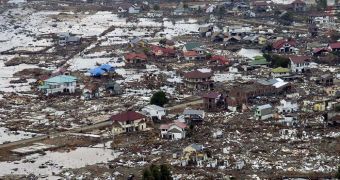Tsunamis are oftentimes produced when earthquakes strike beneath the sea. They are impressive waves that can leave behind a huge trail of devastation, as evidenced by the recent one that struck Japan. Experts now take a look at how these waves form and behave once they reach land.
Their name means harbor wave in Japanese, and this is precisely what they look like. Out in the sea, they rarely look differently than other large waves. It's only when they reach the shorelines that they begin to develop to their full “potential.”
This was again made obvious on March 11 in Japan, when a 8.9-magnitude earthquake that struck 231 miles away from Tokyo generated a 23-foot wave that struck the nation's northeastern coastlines.
The tremor itself was the largest ever to hit Japan, and the fifth largest worldwide since 1900. It generated a series of tsunamis, which went on to hit roads, villages and bridges, demolishing infrastructure and killing up to 300 people.
An additional 350 citizens are reported missing. The tremor was “much bigger than any earthquake we’ve ever had in the lower 48 states,” says Northwestern University professor of geology Seth Stein.
This helped spur a tsunami that literally swept across the Pacific Ocean. By the time it reached Hawaii, which is located some 4,000 miles away, much of its energy had dissipated, so it caused no damage.
“What’s happening off the east coast of Japan is there’s an ocean plate which is dipping down underneath the plate that’s making up Japan and Asia. One is sliding underneath the other,” explains researcher Andrew Campbell.
“And that sliding action causes a lot of earthquakes,” adds the scientist, who holds an appointment as an associate professor of mineral physics at the University of Chicago, in Illinois.
As the tectonic plates under the Pacific Ocean and Asia meet, the former goes over the later. However, the motion can become jammed, which is when tension starts accumulating. When the plates finally slid past each other, the event is sudden, and generates earthquakes, volcanic eruptions and tsunamis.
“The sea floor pops up and, as a result, it displaces the water and pushes it up, The tsunami travels across the water pretty fast and then as it gets close to the shore, it slows down and as it slows down it gets bigger,” Stein reveals.
As the massive waves bunch up, they start accumulating energy and pressure. The power of a tsunami is therefore directly correlated to how slow its traveling and how large it is. From a physical perspective, the harbor waves are just regular waves, only a lot bigger.
“The tsunami wave travels about the speed of a jet plane, about 500 miles per hour. So it takes as long to fly there as it would for the wave to get here,” the expert goes on to say.
Because of its momentum and energy, it takes a long time for the tsunami to stop once it hits the shorelines, which is why it travels so far inland, causing massive damage.

 14 DAY TRIAL //
14 DAY TRIAL //